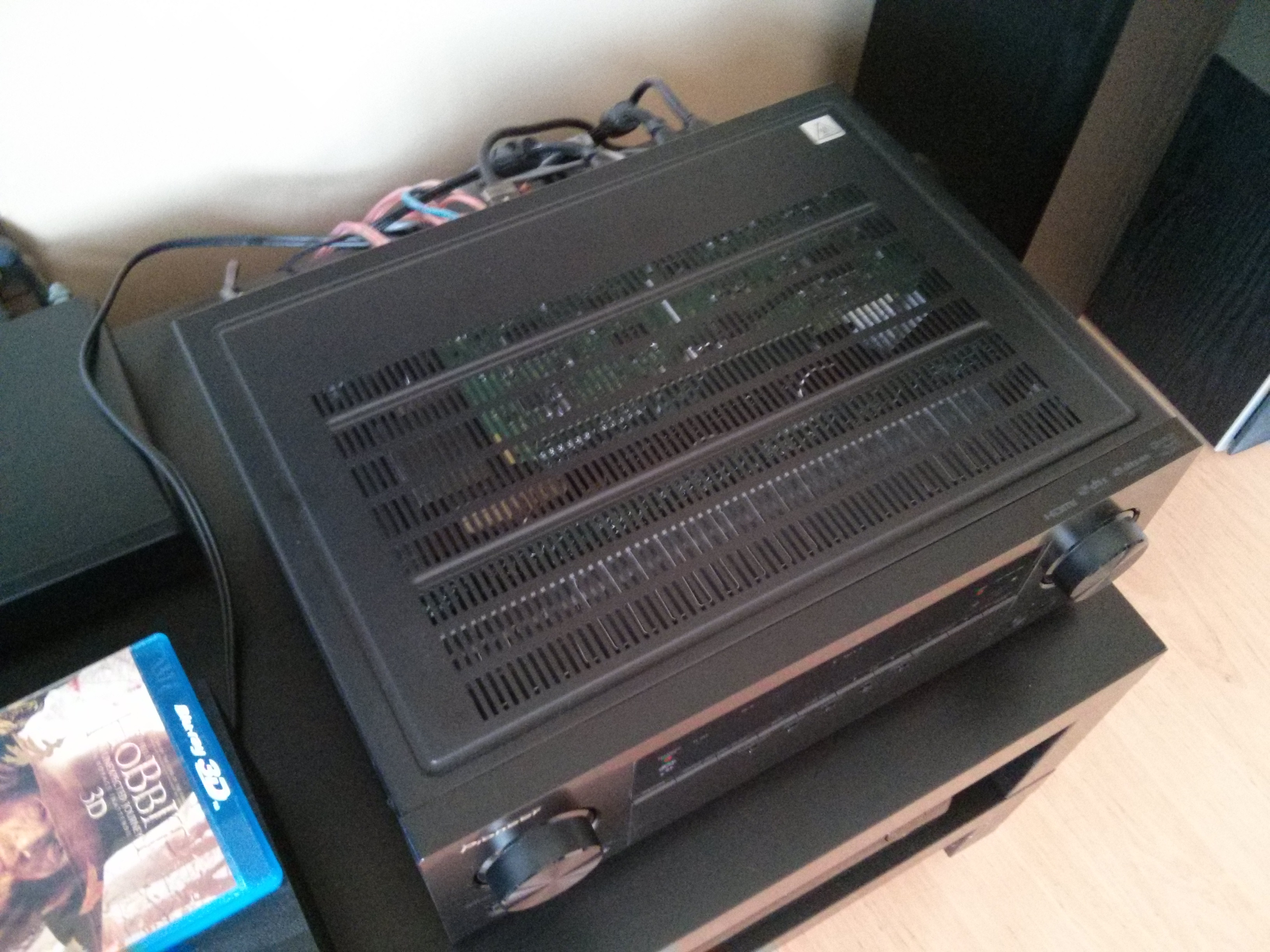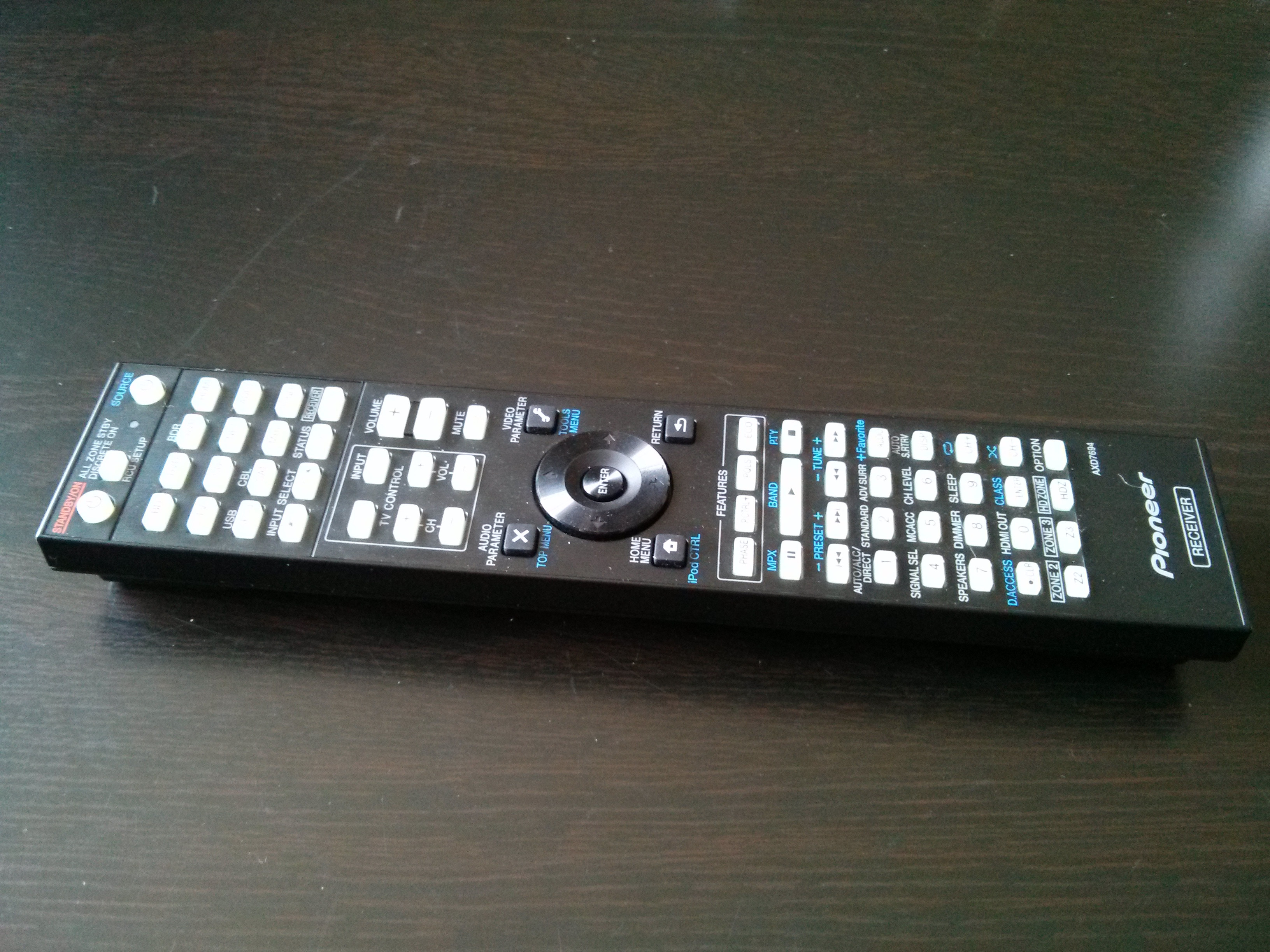The Pioneer VSX-1123-K, released in 2013, stands as a flagship non-Elite series receiver packed with features designed to elevate your home theater experience. From wireless connectivity options like Airplay and HTC Connect to advanced audio processing and video upscaling, this receiver aimed to be a central hub for both audio and video enthusiasts. Let’s delve into the specifics of the VSX-1123-K and explore what it offered and how it performs.
One of the standout features of the Pioneer VSX-1123-K is its comprehensive support for network functionalities and wireless streaming. It integrates seamlessly with Apple’s Airplay, allowing users to effortlessly stream music from iOS devices. For Android users, HTC Connect and Push Play functionalities through the iControlAV2013 app provide similar convenience. Furthermore, DLNA support ensures compatibility with a wide range of devices for media streaming across your home network. Internet radio and Pandora expand your audio content options directly through the receiver.
Beyond streaming, the VSX-1123-K boasts an extensive array of audio codec support, including lossless formats, catering to audiophiles seeking high-fidelity sound. Video capabilities are equally impressive, with upscaling of sources to both HDMI and 4K resolutions, ensuring your content looks its best on modern displays. Audio Return Channel (ARC) simplifies connections with compatible TVs, and 3D capability ensures compatibility with 3D Blu-ray content and displays. The receiver offers flexibility with dual HDMI zones and dual audio zones, allowing for multi-room audio and video distribution. Power output is rated at 90 watts per channel into 8 ohms and 165 watts per channel into 6 ohms. It’s important to note that these wattage figures should be considered within real-world listening contexts. The VSX-1123-K utilizes Class A/B amplifiers, known for their balance of power and audio fidelity.
Mastering Your Sound with Pioneer MCACC
A crucial element for optimizing audio performance in any home theater setup is room acoustics. Pioneer incorporates its proprietary MCACC, or Multi-Channel Acoustic Calibration System, into the VSX-1123-K to address this. MCACC is software designed to automatically tailor the receiver’s audio output to the specific characteristics of your listening room.
 Pioneer VSX-1123-K receiver rear panel connections
Pioneer VSX-1123-K receiver rear panel connections
To utilize MCACC, you connect the included microphone and place it at ear level in your primary listening position. Running the full auto MCACC calibration, using “ALL CH ADJ” and appropriate speaker settings such as Normal (SB/FH), Normal (SB/FW), or Speaker B (depending on your speaker configuration), initiates the optimization process. It is generally recommended to avoid the THX speaker setting unless you are using certified THX speakers. A minimum 5.1 speaker system is required for the full auto calibration. The author’s experience involved setting the receiver to Speaker B during MCACC setup. After the initial calibration, the results can be copied to multiple memory slots for backup and customized tweaking. While copying results provides a safety net, adjustments to speaker distance and levels can be made on individual memory slots to fine-tune the audio to personal preferences. MCACC also includes a helpful feature that detects and alerts users to phase issues with speaker wiring, ensuring correct positive and negative terminal connections.
Thermal Performance and Amplifier Class
Heat management is a key consideration for AV receivers, especially those employing Class A/B amplifiers. The VSX-1123-K is designed with good ventilation in mind, featuring substantial gaps in the chassis to facilitate heat dissipation. The author noted that this receiver generates less heat compared to previous units, alleviating concerns about excessive heat buildup associated with Class A/B amplifiers. While the ventilation design is effective, placing objects directly on top of the receiver is generally discouraged to ensure adequate airflow. The improved thermal performance is a welcome feature, contrasting with older receivers that could generate significant heat.
Understanding Crossover Frequency and Bass Management
Crossover frequency, often denoted as X.Over, is a fundamental aspect of subwoofer integration in a home theater system. It defines the frequency point at which the Low-Frequency Effects (LFE) channel, or the .1 channel in a surround sound setup, is filtered for the subwoofer. Frequencies above the crossover point are not directed to the subwoofer. Interestingly, movie soundtracks are often mixed to include LFE information in other channels to accommodate systems without subwoofers, although the exact proportion is not precisely defined.
Setting the subwoofer mode to “Plus” on the VSX-1123-K bypasses the crossover setting, sending all bass frequencies to the subwoofer. When front speakers are configured as “Large” and the subwoofer is set to “Yes,” the full frequency range of the left and right front channels is directed to the large speakers. For example, with front speakers having a frequency response of 37Hz to 20kHz and a subwoofer covering 37Hz to 200Hz, and a crossover set at 80Hz with “Large” speaker setting, the front channels will reproduce the full spectrum, while the subwoofer will handle the LFE channel content at 80Hz and below. The LFE channel typically extends up to 120Hz, making 80Hz a common crossover point. This is partly due to Dolby LFE content primarily residing at 80Hz and below, with DTS containing only a small percentage of LFE information between 80Hz and 120Hz. Furthermore, frequencies around 80Hz and lower become less directional to the human ear. While setting a higher crossover like 120Hz or 150Hz can capture the full LFE track, a crossover is crucial for “small” speakers, directing lower frequencies to the subwoofer and higher frequencies to the smaller speakers. For more in-depth information on MCACC and crossover settings, the AVS Forum MCACC thread is a valuable resource.
Navigating Sound Modes: DIRECT, PURE DIRECT, ALC, and AUTO SURROUND
A common point of confusion for users of receivers like the VSX-1123-K is understanding and correctly utilizing the various sound modes. Failing to explore these settings and understand their impact can lead to a suboptimal audio experience. The manual is a vital resource for deciphering these options. Key sound modes to understand include DIRECT, PURE DIRECT, ALC (Auto Level Control), and AUTO SURROUND.
 Pioneer VSX-1123-K receiver front panel display and controls
Pioneer VSX-1123-K receiver front panel display and controls
DIRECT mode aims to reproduce sound with minimal modification, second only to PURE DIRECT. In DIRECT mode, the primary processing applied to the audio signal is the room correction from MCACC and Phase Control. PURE DIRECT mode offers the most unprocessed audio playback, minimizing digital signal processing to channel level and distance settings from calibration. PURE DIRECT bypasses EQ and Standing Wave correction present in DIRECT mode. ALC (Auto Level Control) is designed for consistent listening levels, particularly useful for nighttime viewing, by leveling out volume differences across channels. AUTO SURROUND mode intelligently selects the most appropriate surround sound processing mode based on the input signal.
The author prefers DIRECT mode for general listening, appreciating the subtle enhancements from MCACC while maintaining a lively sound, especially for movies. This preference is subjective, and other modes may be preferred based on individual taste and content. Compared to the Harman Kardon AVR 2650, the VSX-1123-K is praised for its balanced sound profile, avoiding a “boomy” bass and achieving a better equilibrium between highs, mids, and lows. The Pioneer, after MCACC calibration and fine-tuning, provides a more immersive theater-like sound compared to the previously used Harman Kardon receiver.
iControlAV2013 App and Network Features
The iControlAV2013 app enhances the user experience of the VSX-1123-K by providing convenient control and access to features via smartphones and tablets. The app is available for both Android and iOS platforms. Using an Android Nexus 4, the author highlights the app’s utility for browsing music libraries on DLNA servers and the device itself. The “Push Player” functionality mimics Airplay for Android, offering a user-friendly interface for music playback. Volume control via the phone’s rocker directly adjusts the receiver’s volume. A persistent notification icon provides quick access to music playback controls. The app enables remote power on/off of the receiver (requiring Network Standby to be enabled in the receiver’s menu), source and zone switching, volume adjustment, input selection, listening mode changes, balance, phase control, bass and treble adjustments, and more. The iControlAV2013 app essentially provides a visual remote control interface. While the app is primarily used for music playback, the physical remote is preferred for TV and movie watching.
DLNA server connectivity is another strong feature of the VSX-1123-K. The receiver seamlessly integrates with DLNA servers, including media server software like Plex. This allows for effortless streaming of digital music libraries, with support for lossless audio formats, eliminating the need for transcoding. The author notes potential issues with Windows built-in DLNA server functionality, citing connectivity inconsistencies. Third-party DLNA server applications like Plex, TVersity, or Twonky are recommended for more reliable performance and broader compatibility compared to Microsoft’s proprietary implementation.
 Pioneer VSX-1123-K remote control
Pioneer VSX-1123-K remote control
Remote Control, OSD, and Connectivity Options
The included remote control for the VSX-1123-K offers a wealth of buttons and functions. The abundance of buttons is seen as a positive aspect, providing direct access to numerous receiver functions. Learning the remote’s capabilities is encouraged for efficient control. It can also function as a universal remote, learning IR codes from other devices, potentially reducing remote clutter. While the remote is described as lightweight and somewhat flimsy in feel, button responsiveness is praised. The inclusion of a receiver function lock button is a useful feature, especially in households with children, preventing accidental setting changes.
The On-Screen Display (OSD) is described as functional rather than aesthetically pleasing. The focus is rightly placed on the receiver’s performance and sound quality over visual interface aesthetics.
Connectivity options include wired Ethernet for network functions. Wi-Fi and Bluetooth are available via optional adapters purchased separately. The author prefers wired Ethernet for network connectivity due to its reliability. Bluetooth audio streaming is generally avoided due to potential quality loss and susceptibility to interference, particularly for audiophiles. While Pioneer claims to have technology to improve Bluetooth streaming quality, details are scarce. The author speculates that only a buffering-based approach could truly preserve original audio quality over Bluetooth. Pioneer’s devices are noted to be Apple-friendly, with AirPlay and related features.
The VSX-1123-K offers ample HDMI connectivity with 7 inputs and analog-to-HDMI conversion with 4K upscaling. A second HDMI zone output allows for routing different video sources to a second display. Zone B speaker outputs further expand multi-room audio possibilities. HDMI pass-through functionality is supported even when the receiver is off, passing through the last selected HDMI source.
Zone 2 Functionality and Advanced Features
Zone 2 setup can initially seem complex to users. However, by consulting the manual (RTFM – Read The F*** Manual), Zone 2 functionality becomes accessible. Zone 2 settings are configured within the receiver’s menu under “System Setup,” “Manual SP Setup,” and “Speaker System,” where you select “ZONE 2.” Then, under “Other Setup” and “Play ZONE Setup,” set “Play ZONE” to “ZONE 2.” For the secondary HDMI zone, adjustments to HDZONE settings are necessary.
The VSX-1123-K provides extensive video adjustment options, including contrast, hue, and saturation controls, mirroring the comprehensive audio settings.
ARC (Audio Return Channel) is supported for simplified audio connection from compatible TVs. Unlike previous experiences, ARC setup with the VSX-1123-K was straightforward. Enabling “Control On” and “ARC On” in the receiver’s HDMI settings and activating the corresponding CEC control on the TV (e.g., AnyNet+ for Samsung, SIMPLINK for LG) enables ARC functionality. HDMI 1.4 or later specification cables are required for ARC to function. The author tested ARC with Netflix and confirmed DD 5.1 audio playback. While some sources suggest potential HDMI board strain from ARC, and recommend optical connections instead, the author found ARC to be reliable. The Geffen HDMI Detective, previously used to resolve HDMI issues with a Harman Kardon receiver, is no longer needed with the VSX-1123-K, suggesting HDMI board issues were specific to the older receiver.
Optimizing Your Audio Experience
While plug-and-play convenience is appealing, truly maximizing the audio potential of the VSX-1123-K requires user engagement and exploration of its settings. Running Advanced MCACC is a good starting point, but further customization is encouraged. Experimenting with basic settings like speaker levels and balance, and delving into EQ adjustments based on your room and listening preferences, can significantly enhance the audio experience. Investing time in understanding and tweaking the receiver’s functions is key to unlocking its full potential and achieving optimal home theater sound.
The author acknowledges the valuable assistance from the AVS Forum MCACC thread community during the setup and learning process. The forum is recommended as a resource for AV-related questions and discussions.
Final Verdict
The Pioneer VSX-1123-K receives an 8 out of 10 rating. While the manual could be clearer, particularly regarding crossover settings, the receiver’s sound quality and connectivity are highly impressive.
Share this:
Like Loading…

